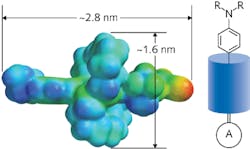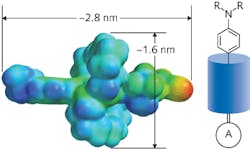Organic electro-optic materials can be easily processed onto any device platform including silicon ring resonators, silicon slot modulators, and plasmonic Mach–Zehnder modulators. The materials also have the potential to be integrated with electronics for future high-performance optical interconnects and for use as key building blocks of highly integrated photonic circuits. Unfortunately, organics are photosensitive and the active component (a chromophore) is highly dipolar and crystalline, and thus easily scatters light. In addition, the softness of the component’s matrix makes it hard to prevent chromophore aggregation and maintain the alignment typically obtained by electric-field poling.
To prevent this aggregation and improve the prospects for silicon-organic components, the Zhang group at South Dakota State University (Brookings) has devised a new way of isolating chromophores to prevent aggregation and photodegradation while demonstrating for the first time that the electro-optic coefficient can scale up with chromophore concentration to 100%. Using a specially designed and synthesized chromophore shape, the researchers hide the chromophore in a cylindrical container molecule that both reduces interchromophore reactions and protects against photo-oxidation. The new strategy may eventually lead to highly electro-optic active organic materials that can operate in air for years. Contact Cheng Zhang at [email protected].

